Your chickens will need properly formulated chicken feed that is the correct type for their age, for growth, sustenance and to produce eggs if they are hens of egg laying age. There are many old wives tales and alternative views on feeding, some say it’s marketing that has created all of these feeds and hens will survive well on wheat and others will say their grandad never had layers pellets and just fed his hens kitchen scraps! Formulated poultry feeds didn’t exist until recently, primarily created thanks to commercial research on hens diets as we tried to squeeze more and more eggs out of hens.
In days gone by though when ‘grandad fed scraps’, pure breeds were kept for eggs and they were fed grain mixes or dried mash chicken feed that had meat or fish meal added to increase the protein content. Hens would free range over a large area and could also supplement their diet with what they could forage. Bugs, insects and worms are all valuable sources of protein, not forgetting a good selection of greens providing vitamins and minerals.
“Grandad’s chickens didn’t get chicken feed and survived on kitchen scraps but they could free range to top up their diet on protein, vitamins, minerals and calcium from the fields or orchards they grazed. They didn’t produce anything like the number of eggs modern hybrid hens or some pure breeds produce.”
So in short, if you don’t feed a proper formulated layers feed to your hens, they won’t be able to keep up the demands that egg-laying puts on their bodies.
Layers Feeds and Protein
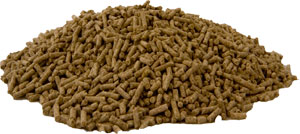 Chickens require protein to produce feathers and eggs as well as to grow. The amount of protein in their diet is important and you will see on the ingredients on the back of bags of commercial feeds the percentage of protein that they contain. It is higher in ‘Growers Pellets’ for example to enable chickens to grow and produce feathers. You will find that chickens stop laying eggs when they moult (lose their feathers and regrow new) as they are diverting protein from egg production to feather production. During the moult, you can scatter a handful of cat kibble in the run which helps them to top up with protein. Do not use dog food as most of the protein is derived from cereals.
Chickens require protein to produce feathers and eggs as well as to grow. The amount of protein in their diet is important and you will see on the ingredients on the back of bags of commercial feeds the percentage of protein that they contain. It is higher in ‘Growers Pellets’ for example to enable chickens to grow and produce feathers. You will find that chickens stop laying eggs when they moult (lose their feathers and regrow new) as they are diverting protein from egg production to feather production. During the moult, you can scatter a handful of cat kibble in the run which helps them to top up with protein. Do not use dog food as most of the protein is derived from cereals.
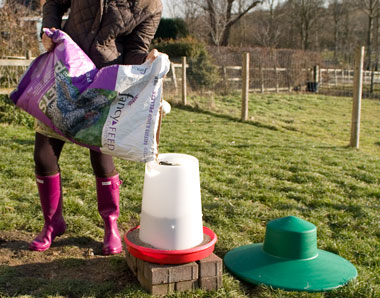
Commercial feeds contain the right balance of nutrients & can be fed ad-lib in hoppers if kept dry. This one has a rain hat.
Commercial chicken feeds have been well researched and contain the correct balance of minerals and nutriets required by chickens as well as sufficient protein and calcium which is essential for egg shell production. Layers pellets for example are around 16% protein. Wheat is about 10% protein and lacks essential vitamins that are required by chickens.
Formulated feeds come as pellets or mash and should be fed ad-lib so hens can take what they want as they need it. This type of feed must be kept dry or it will soon spoil. The feeder and rain hat shown above is the only sort I have found that really does keep the feed dry. Most have a hole in the top of the hat for a handle or for hanging and this lets water in. A feeder and rain hat similar to this one can be bought from Omlet.
Eggs are made up of around 80% protein so if there’s a shortage of protein in their diet, egg laying will be the first thing they your girls cut back on!
There is more information on the poultykeeper.com site which has a very good page of feeding chickens and chicken feed.
Mixed corn
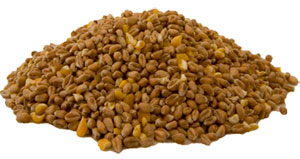 Mixed corn is usually 80 to 90% wheat and 10 to 20% maize. It is useful as a scratch feed, it keeps hens active, scratching around looking for it but should only be considered a treat. A handful per hen thrown late afternoon helps them to have a full crop overnight.
Mixed corn is usually 80 to 90% wheat and 10 to 20% maize. It is useful as a scratch feed, it keeps hens active, scratching around looking for it but should only be considered a treat. A handful per hen thrown late afternoon helps them to have a full crop overnight.
The maize (yellow in colour) is very fattening but can be useful during very cold weather to help your hens keep warm – I increase my girls’ ration of corn when it is cold over the winter, after they have finished moulting (they need lots of protein during the moult) since they are not laying eggs and need a little extra fat to burn in order to keep warm.
If you feed too much corn, your hens will get fat and fat hens don’t lay eggs!
Household scraps
Feeding household scraps is no longer allowed according toi DEFRA and can be a bit hit and miss anyway. You don’t really know what a hen is getting and the diet is very unbalanced. It is for this reason that scraps used to be mixed into a mash by using layers mash and water (which can be warm in winter). The mixture should be a sort of crumbly mix, not too wet but not too dry. Feeding scraps should be limited to at most 25% of a hens diet so as not to tip the balance too far one way or another.
Greens
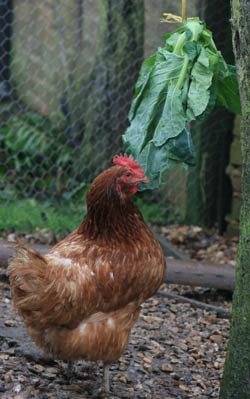 Ample green stuff should be provided for your hens. Grass cuttings, weeds and off-cuts from cabbages, cauliflowers and other greens can be provided at minimal cost. Lettuce should be fed in moderation because it has very little nutritional value (very little Protein and Energy / Calories) and avocado pear is poisonous to hens but most other greens that come from the kitchen will be appreciated by your girls. Try hanging greens in their run, just a little higher than they can reach. As they eat them, they will need to jump to get the last bits so will be getting exercise at the same time as their greens! Win-win!
Ample green stuff should be provided for your hens. Grass cuttings, weeds and off-cuts from cabbages, cauliflowers and other greens can be provided at minimal cost. Lettuce should be fed in moderation because it has very little nutritional value (very little Protein and Energy / Calories) and avocado pear is poisonous to hens but most other greens that come from the kitchen will be appreciated by your girls. Try hanging greens in their run, just a little higher than they can reach. As they eat them, they will need to jump to get the last bits so will be getting exercise at the same time as their greens! Win-win!
If you have an area in which you can grow cabbages in your garden, it may be worthwhile thinking about growing a row for the winter. Cabbages will sit there in the cold, perfectly preserved until picked. You will need to keep them covered with fleece when there are cabbage white butterflies around but don’t worry if they are a little eaten, the chooks won’t mind!
Mealworm treats
Many chicken keepers like to buy mealworms or chicken treats containing these. Chickens love these and are easily tamed by using such tasty treats, however you should keep in mind that animal by-product regulations mean that mealworms are not really allowed to be fed to poultry.

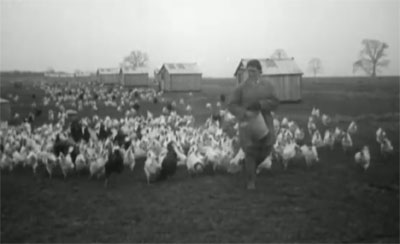
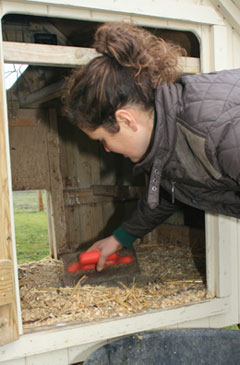
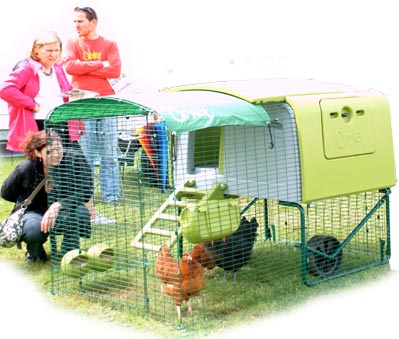
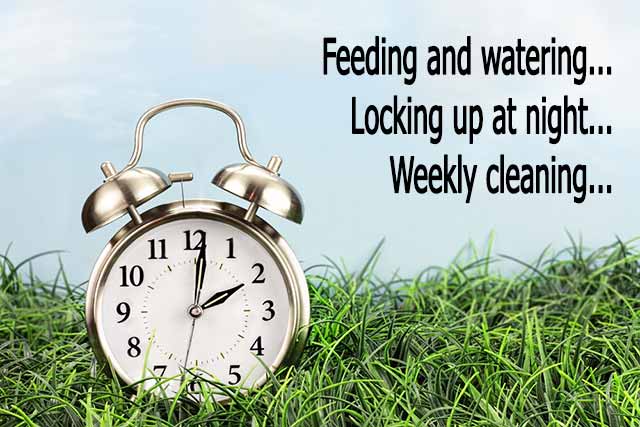
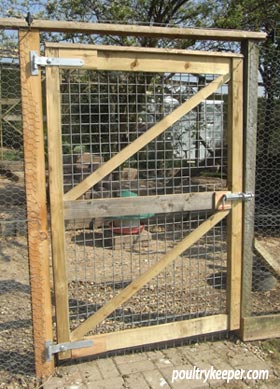
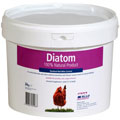
Hi, Sue and I have just given a home to 6 rescued ex battery hens from fresh start for hens. We have had them for a week and they have settled well and are enjoying their freedom. They have a very large coop and we have added additional safe covered areas onto the original coop. We are feeding as directed by the local freshstart for hens co-orndinator but can you advise if we can also give them raw cabbage leaves/sprouts etc or do they need to be cooked first?
Raw / fresh greens are fine to give hens but they won’t always eat them. They acquire the taste if brought up with it.
Potato peelings should be boiled. If you have layers mash (which battery hens are used to) then you can boil up some greens / scraps and drain off the water, add mash until you get a nice crumbly mixture to feed them. Be warned though, this feed can then be unbalanced and they may not be getting enough protein for their recovery and growth of new feathers so during the early days I would stick with something like Smallholder Range Ex Batts Crumbs which is formulated specifically for them.
Our chooks (4 hens, 1 cockerel) get layers pellets in the morning, which last them all day as they seem to not like them much. We give them a handful of wheat/corn in the afternoon as a treat and plenty of greens & fruit scraps. We’ve found they eat the pellets with a little more enthusiasm if we add water to them. Any leftover mush is chucked out in the evening. Is there anything else we could do to encourage them to eat the pellets?
Chickens will always prefer corn over pellets. If they are fussy, you will usually find they eat the pellets once they are hungry enough. It is possible they are eating enough (they won’t starve themselves) – if you measure out their food, they should eat around 80 to 110 grams per day each but this can be lower if they get food from other sources such as they find when free range or corn / treats etc.
hi can you please tell me how i can sex my 2 week old chicks 2 chicks seem to have longer wings many thanks heather
I am afraid it isn’t possible to sex them until they are older and combs / wattles develop unless they are an autosexing breed where you can tell by the colour or pattern on their down as day old chicks. Sometimes cocks have more pointed feathers but it’s hard to tell reliably.
i have just got 4 hybrid hens 20wks old. they have pellets. what else can i give them . also when and how would be the best way to introduce them to my dog
Please read my page on Feeding Chickens and Chicken Treats for more ideas.
Although I have a dog, I don’t regularly need to introduce dogs to my chickens so I don’t know the best way to do this. Slowly and on a lead I guess… Some dogs seem to be fine with chickens, others not so…